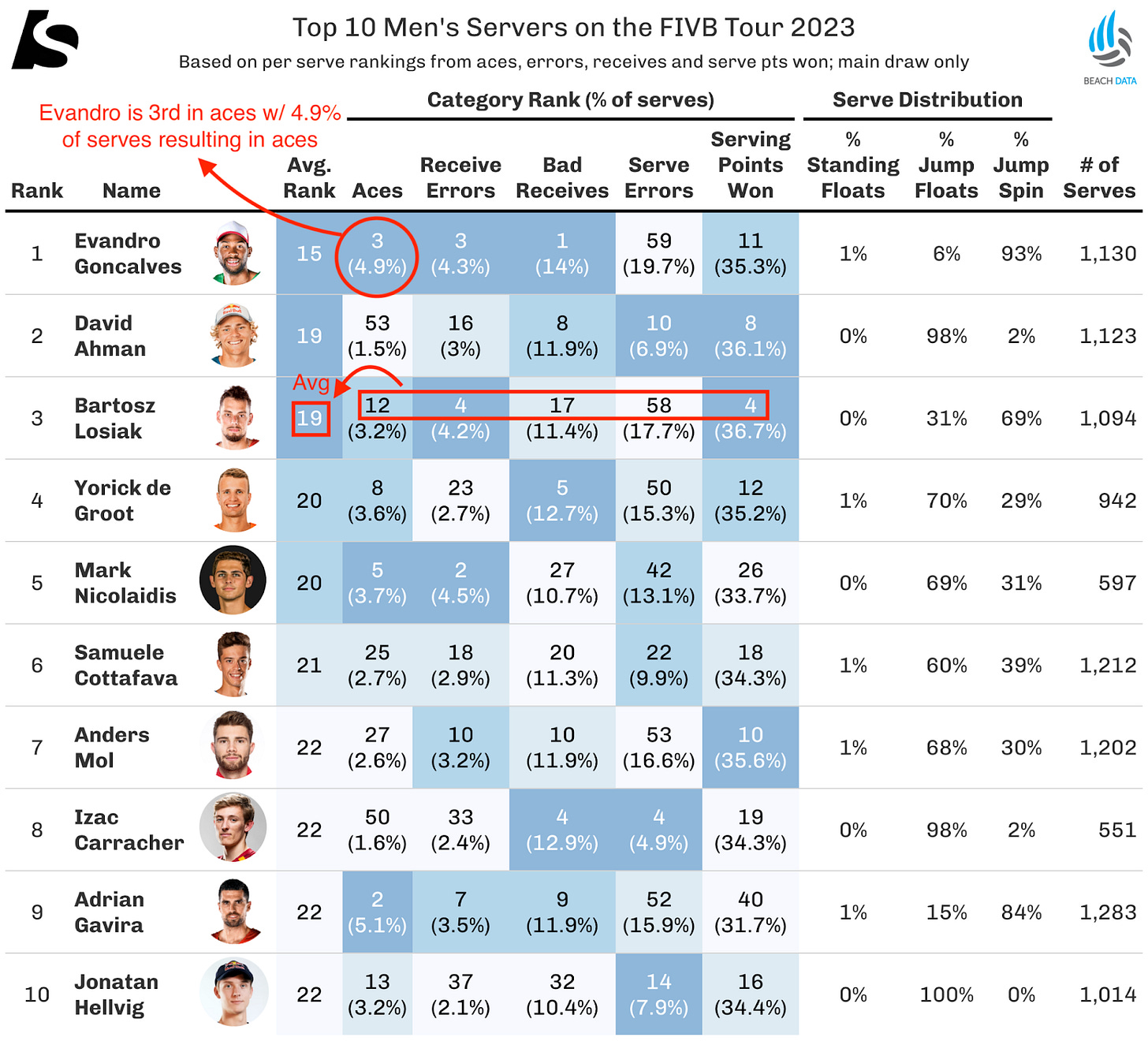Who are the best servers on the FIVB beach volleyball world tour?
Part 2 in our series of using rally level data to dig deeper into serving strategies in beach volleyball
In our previous post, we looked at the prevalence of different serve types and the tradeoffs among them. We saw that jump spin serves generated the most aces and receive errors at the cost of almost doubled serve errors.
So, how can we use this data to find the best servers on the FIVB World Tour in 2023?
Unlike other publications that only look at basic stats like the # of aces, we’ll consider 5 categories to get the most thorough picture of the best servers:
Aces - unreturnable or untouchable serves
Receive Errors - serves that forced a reception error
Bad Receives - serves that forced a bad reception
Serve Errors - missed serve
Serving Points Won - % of points won when serving
We weigh each category equally based on how the player’s stat ranks against other players. For example, out of all of Evandro’s serves, 4.9% resulted in aces, ranking him 3rd in this category.
We then average these rankings across categories to get the final order.
Men’s Top 10
It’s no surprise that Evandro is the best server given his aggressive jump serve style of play (93% of serves are jump spin serves). From his serves, 5% result in aces, 4% result in receive errors, 14% in bad receives. However, he misses about 20% of his serves, or close to last on tour. He also ends up winning about 35% of serving points when he is serving, ranking 11th among the cohort. This stat likely favors players who not only have a great serve but also great defense, blocking and transition sideout %.
Rounding out the top 10, some players are defensive specialists who aren’t as aggressive on their serves while also maintaining a low serve error rate.
David Ahman is rated as the 2nd best server. Although he is ranked close to last for aces, he forces 12% bad receives, has a low serve error %, and is 8th in winning points on serve, likely attributed to his stellar defense and transition offense.
We also see that players who are more likely to go for their jump serves have better ace, receive error, and bad receive stats. For example, Bartosz Losiak serves close to 70% jump spin serves, ranking 12th in aces, 4th in generating receive errors, and 17th in generating bad receive passes. Similarly to Evandro, he is near the tail end for serve errors with ~18% of serves resulting in a miss.
Anders Mol utilizes the jump serve occasionally with around 30% of serves being jump spin. This has allowed him to have moderate ace, receive error, and bad receive stats, rounding out the top 10 in 7th place. His blocking ability surely helps his points won stat when he gets on fire to win clutch points.
(Filtered to players who have at least 500 serves in main draw FIVB matches in 2023. Given these filters, there were ~63 men and ~63 womens available for consideration)
Women’s Top 10
On the women’s side, we see Chen Xue as the top server. Her average rank is 13, showing her well-roundedness across all 5 categories. She mostly hit standing floats, but her 6’3” height likely helps hit low float serves above the net to cause problems for opponents
Only the Brazilian women hit some jump serves, 18% and 23% for Solberg and Santos, respectively. Even with this distribution, they don’t get as many aces as others who focus mostly on jump float serves.
Data from Beach Data






It appears that aces and receive errors are highly correlated. I believe some systems don’t even distinguish between the two. I don’t mind that aces + receive errors count twice as much as service errors here. If you serve even half as many aces + receive errors as service errors, that’s still a very good ratio because side out percentages on good passes are pretty high. In fact, I could argue that the risk-reward factor of aces vs service errors should actually rank players like Clancy and Gottardi higher than what you have.
I do think that points scored while serving may be weighted too heavily. Bad receives already accounts for good serves getting opponents out of system, plus as you mention points scored is affected by many other factors other than serving. But I’m not sure I’d remove it altogether either.
Hope you’ll continue the good work!
Good stuff again. The men’s top ten rankings look fairly reasonable. The most surprising omissions for me on the women’s side are Clancy and Gottardi. A couple of questions:
1. What is the difference between receive errors and bad receives? The description isn’t clear.
2. In determining the overall ranking, you weighted each of the five categories equally, for simplicity I assume. Obviously you could do more analysis to determine the optimal weighting, but I’m curious which categories you think should count more in determining the best servers?